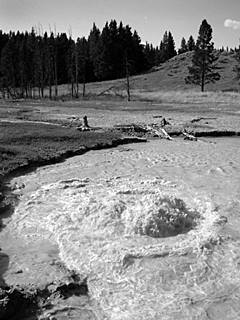
- 28 August 2001
- Boiled Like a Lobster
- Yellowstone National Park really doesn’t feel like a park at all, it’s more like an open-air natural history museum. And although I haven’t been around that much, I don’t know that many other places where one can see killer geysers. (Yellowstone’s thermal waters have killed some twenty people in recent history.)
I didn’t really think too much about boiling to death until I met the father of one of the geyser statistics at Hell Hole Springs. He told me the story of how his daughter took a shortcut after sunset one night. One wrong step, and she fell into a thermal pool.
“She had third-degree burns over almost all of her body,” he reported. “The water was eighty-seven degrees Celsius, one hundred and eight-nine Fahrenheit. She lived through the night, and passed away in the morning. That’s the way it usually works; it takes a while to die from burns.”
I didn’t know what to say, so I just nodded.
The dead girl’s father went on to tell me much more than I ever wanted to know about being boiled alive; he ended up with a story about a party in Portland, Maine. He was visiting old family friends when he saw his cousin tossing live lobsters into a cauldron of boiling water. He said he broke down, and was “out of the world” for over a year.
That’s when I finally realized that the distressed father had been compulsively chewing on raw carrots for half an hour.

- 29 August 2001
- Yellowstone Spray Scam
- I see huge, lumbering “recreational vehicles” everywhere I look in Yellowstone National Park. They dot the landscape—and clog the roads—like so many behemoth aluminumasaurs. I also see buffalo, idiots, and lots of other things I’ve seen elsewhere.
I must admit, however, that I’ve never seen insulated beer holsters before. Half the people have insulated beer holsters hanging off their belts, an accessory I wish I had on this hot day.
Eventually, I asked a guy where he got his beer holster thingie.
“At the general store,” he replied. (The corporation that operates a chain of retail outlets in the national parks uses the quaint, folksy name of “general store” to make tourists feel better about buying overpriced junk.)
“How much was it?” I inquired.
“Forty-five bucks,” he answered, “and worth every penny.”
Now, I like a cold beer on a hot day as much as the next person, perhaps even more. But forty-five dollars?!
After a while, I began wondering whether I misunderstood the price, so I asked a sunburnt woman how much she paid for her insulated beer holster. And that’s when I discovered that the insulated beer holsters weren’t insulated beer holsters at all!
It turns out that the sightseers were carrying canisters of pepper spray to defend themselves from an extraordinarily improbable bear attack. Although I don’t know that much about ursine interactions, I’d wager that trying to douse an aggressive bear with pepper spray would often just result in an antagonized, angry, and aggressive bear.
I think most of the silly people suffering from agrizoophobia would probably be better off with insulated beer holsters instead of pepper spray. After all, I’ve been drinking beer in the woods for decades, and I’ve never had any unpleasant encounters with wildlife. (Whether or not the animals residing in Yellowstone are wildlife is another question for another day.)

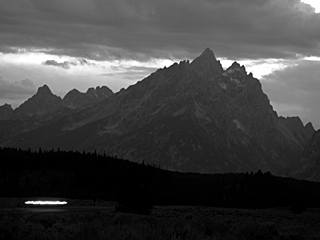
- 30 August 2001
- Tetons?!
- Once upon a time, some French trappers had a look at some of the most distinct mountains in North America and declared them to be
“Les Trois Tetons” (The Three Breasts). And even today, they’re still called the Grand Tetons, or Large Breasts.Large Breasts?!
I understand that an extended lack of physical intimacy can lead to substantial errors in judgment, but Grand Tetons?! Very silly, very French.

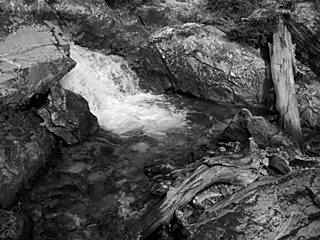
- 31 August 2001
- Conceptual Temperatures of Mountain Waters
- The Rocky Mountains are full of rivers, and those streams are full of clear, lovely pools. Unfortunately, most of these swimming holes aren’t really swimming holes at all: they’re usually just too cold.
I’m not sure just how cold; I don’t travel with a thermometer. (I don’t like to carry unnecessary weight when I’m hiking in the mountains, so I pack a gas stove and stovetop espresso machine and leave the thermometer at the lab.)
I am, however, quite familiar with the relative temperatures of glacial waters. These temperatures have nothing to do with conventional Fahrenheit or Celsius scales; the coldness of mountain waters is entirely dependent on how many days the viewer has been without a bath or shower. Here’s a rough guide of how to judge the temperature of glacier-fed streams.
Day one (without a bath or shower): Instant unconsciousness followed by imminent death.
Day two: Severe hypothermia within thirty seconds.
Day three: Paralyzing numbness in the extremities.
Day four: Icy, almost intolerably cold.
Day five: Very chilly, only suitable for three- to five-minute swimming and bathing.
And by the sixth day, only the French hikers are still dry.

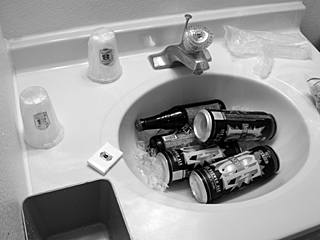
- 1 September 2001
- Dr. Collier’s Travel Sink
- After hundreds of kilometers of hiking, one vision has guided me: Dr. Collier’s travel sink. It’s the practical person’s grail.
Dr. Collier’s travel sink is the perfect conceptual work; almost anyone can recreate it almost anywhere almost anytime. Rent a cheap motel room, buy some beer, and put the beer in the bathroom sink with some ice from the motel’s ice machine. Done!
It works in Boise, Idaho. And if it works in Boise, it will work anywhere.

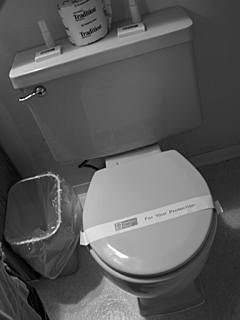
- 2 September 2001
- Dubious Motel Protection
- After checking in at the Cheap and Cheerful Motor Inne in Susanville, I wasn’t surprised to discover that the toilet in my room, like so many other toilets in so many other seedy American motels, was “sealed” with a paper ribbon, ostensibly “For Your Protection.”
I never thought I needed protection from toilets. From what I’ve read, only contortionists with extraordinarily perverse use of bathroom fixtures could possibly transmit diseases via a toilet seat. I guess dangerous toilet seats are one of those myths that will be around for a very long time.
If motel visitors are concerned about previous guests’ bodily discharges, they should be looking outside the toilets. Most motels clean sheets and towels after each visitor, but bedspreads are another story. I just read that police detectives examined a bedspread from a Holiday Inn in Des Moines, Iowa. The police lab identified over a hundred separate stains, including thirty-eight semen stains.
Enjoy your stay, and pleasant dreams.


